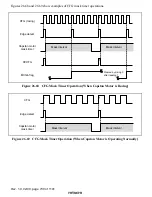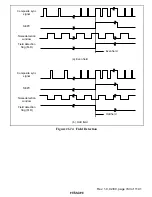
Rev. 1.0, 02/00, page 744 of 1141
26.15.6
Noise Detection
If a pulse of the horizontal sync signal is missing, a complementary pulse is set at the timing set in
HPWR and with the set pulse width.
Set the noise detection window with HWR of about 1/4 of the horizontal sync signal, and the pulse
with equal high and low periods will be obtained.
Example of Setting: Assumed that a complementary pulse is set when fosc = 10MHz under the
conditions
φ
s = 5 MHz, NTSC:TH = 63.6 (
µ
s) and Hpuls = 4.7 (
µ
s), the set values of the
complementary pulse timing (HRTR7-0), complementary pulse width (HPWR3-0), and noise
detection window timing (NWR5-0) are expressed by the following equations.
(Value of HRTR7-0)
×
2/
φ
s = TH
((Value of HPWR3-0) + 1)
×
2/
φ
s = Hpuls
((Value of NWR5-0) + 1)
×
2/
φ
s = 1/4
×
TH
Where, TH is the cycle of the horizontal sync signal (
µ
s), Hpuls is the pulse width of the
horizontal sync signal (
µ
s) and
φ
s is the servo clock (Hz) (fosc/2).
Accordingly,
(Value of HRTR7-0)
×
0.4 (
µ
s) = 63.6 (
µ
s)
∴
HRTR7-0=H'9F
((Value of HPWR3-0) + 1)
×
0.4 (
µ
s) = 4.7 (
µ
s)
∴
HRTR3-0=H'B
((Value of NWR5-0) + 1)
×
0.4 (
µ
s) = 16 (
µ
s)
∴
NWR5-0=H'27
Also, the noise mask period is computed as follows.
((Value of HRTR7-0) + 1)
−
24)
×
2/
φ
s = 54 (
µ
s)
Where, 24 is a constant required for a structural reason.
Figure 26.75 shows the set period for HRTR, HPWR, and NWR.
















































